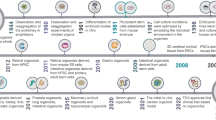Abstract
A new line of human ovarian serous adenocarcinoma cells, TU-OS-4, was established and characterized. The cells showed a short, spindle-shaped morphology and grew in monolayers without contact inhibition while forming an arrangement resembling a jigsaw puzzle. Chromosome numbers ranged from 55 to 73. The proliferation rate was lower than other serous adenocarcinoma cell lines tested (KF, SHIN-3, and SK-OV-3), and the doubling time was 53.3 h. Western blot analysis showed that TU-OS-4 cells overexpressed epidermal growth factor receptor, human epidermal growth factor receptor (HER) 2, and phosphorylated HER2 protein. The IC50 values to cisplatin, paclitaxel, and lapatinib were 25.8 μM, 686 nM, and 183 nM, respectively. Heterotransplantation in nude mice reflected the original tumor of the cells. These results suggested that this cell line would be useful to study chemoresistant mechanisms and contribute to establishing novel treatment strategies for patients with ovarian cancer.






Similar content being viewed by others
References
Global Cancer Facts & Figures. 2nd ed. Atlanta: American Cancer Society; 2011.
Heintz AP, Odicino F, Maisonneuve P, et al. Carcinoma of the ovary. FIGO 26th Annual Report on the Results of Treatment in Gynecological Cancer. Int J Gynaecol Obstet. 2006;95(Suppl 1):S161–92.
Bookman MA, Brady MF, McGuire WP, et al. Evaluation of new platinum-based treatment regimens in advanced-stage ovarian cancer: a Phase III Trial of the Gynecologic Cancer Intergroup. J Clin Oncol. 2009;27(9):1419–25.
Bristow RE, Tomacruz RS, Armstrong DK, Trimble EL, Montz FJ. Survival effect of maximal cytoreductive surgery for advanced ovarian carcinoma during the platinum era: a meta-analysis. J Clin Oncol. 2002;20(5):1248–59.
Monk BJ, Coleman RL. Changing the paradigm in the treatment of platinum-sensitive recurrent ovarian cancer: from platinum doublets to nonplatinum doublets and adding antiangiogenesis compounds. Int J Gynecol Cancer. 2009;19(Suppl 2):S63–7.
Sarup J, Jin P, Turin L, et al. Human epidermal growth factor receptor (HER-1:HER-3) Fc-mediated heterodimer has broad antiproliferative activity in vitro and in human tumor xenografts. Mol Cancer Ther. 2008;7(10):3223–36.
Itamochi H. Targeted therapies in epithelial ovarian cancer: molecular mechanisms of action. World J Biol Chem. 2010;1(7):209–20.
de Graeff P, Crijns AP, de Jong S, et al. Modest effect of p53, EGFR and HER-2/neu on prognosis in epithelial ovarian cancer: a meta-analysis. Br J Cancer. 2009;101(1):149–59.
Hsieh SS, Malerczyk C, Aigner A, Czubayko F. ERbB-2 expression is rate-limiting for epidermal growth factor-mediated stimulation of ovarian cancer cell proliferation. Int J Cancer. 2000;86(5):644–51.
Itamochi H, Kigawa J, Sugiyama T, Kikuchi Y, Suzuki M, Terakawa N. Low proliferation activity may be associated with chemoresistance in clear cell carcinoma of the ovary. Obstet Gynecol. 2002;100(2):281–7.
Dimanche-Boitrel MT, Pelletier H, Genne P, et al. Confluence-dependent resistance in human colon cancer cells: role of reduced drug accumulation and low intrinsic chemosensitivity of resting cells. Int J Cancer. 1992;50(5):677–82.
Barcellos-Hoff MH, Marton LJ, Deen DF. Differential drug sensitivity conferred by growth status detected in a mixed population of cycling and noncycling cells. Cancer Res. 1990;50(12):3551–5.
Agarwal R, Kaye SB. Ovarian cancer: strategies for overcoming resistance to chemotherapy. Nat Rev Cancer. 2003;3(7):502–16.
Ma WW, Adjei AA. Novel agents on the horizon for cancer therapy. CA Cancer J Clin. 2009;59(2):111–37.
Acknowledgment
This work was supported by a Grant-in-Aid for Scientific Research from the Ministry of Education, Culture, Sports, Science and Technology of Japan (17244120 to H. Itamochi).
Conflict of interest
The authors declare that they have no conflict of interest.
Author information
Authors and Affiliations
Corresponding author
Rights and permissions
About this article
Cite this article
Itamochi, H., Kato, M., Nishimura, M. et al. Establishment and characterization of a novel ovarian serous adenocarcinoma cell line, TU-OS-4, that overexpresses EGFR and HER2. Human Cell 25, 111–115 (2012). https://doi.org/10.1007/s13577-012-0048-1
Received:
Accepted:
Published:
Issue Date:
DOI: https://doi.org/10.1007/s13577-012-0048-1




